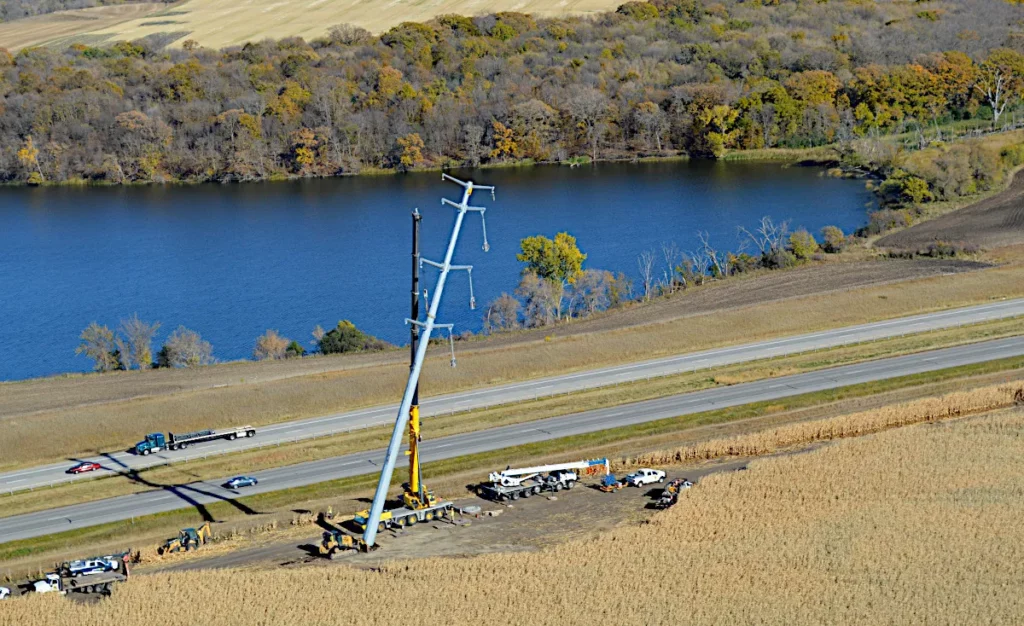Workers set a transmission tower for the Capx 2020 line along a Minnesota highway. Photo via Xcel Energy.
Since the summer of 2022, when the landmark Inflation Reduction Act became law, the U.S. has witnessed a stunning surge in clean energy investment. Hundreds of billions of dollars in private investment have poured into new clean energy projects across the country — revitalizing American manufacturing by driving the creation of more than 150 new clean energy factories and creating thousands upon thousands of good-paying, local jobs.
Amid all the activity, states have been working to compete for their share of both private and federal investment. And Minnesota is wasting little time. In the past two years, Minnesota passed three pieces of legislation that put the state in a great position to capture investment and jobs from building clean energy infrastructure, and reliable and affordable electricity from getting it all online.
First came the state’s commitment to 100% clean power. In early 2023, shortly after state lawmakers convened and a few months after the Inflation Reduction Act went into effect, the Minnesota Legislature established one of the most ambitious clean power laws in the country by pledging to fully power the state with pollution-free electricity by 2040. The law served as an important signal to investors and developers that Minnesota is committed to leading the transition to a clean energy economy.
Despite that, Minnesota has seen slow growth in clean energy investment since that law passed. According to the Clean Energy Monitor, Minnesota has trailed most of the nation in new clean energy projects over the past year. What’s more, researchers found that Minnesota was well off-pace to meet that 100% goal and would fail to hit the 2040 deadline by a matter of decades.
So, in a bid to accelerate things, Minnesota lawmakers took on another issue this year — permitting reform, a challenge that has come up in several other states across the country. The slow process to permit new clean power infrastructure has become a significant barrier to getting new projects online. To meet its 2040 goals, Minnesota would have to find ways to speed up the state’s approval process.
And this spring, policymakers did just that with the bipartisan Minnesota Energy Infrastructure Permitting Act. This important reform to the state’s permitting process was supported by major businesses that want to see more clean energy come online quickly, such as Google, REI Co-Op, and Holcim. The Minnesota Energy Infrastructure Permitting Act will consolidate certain permitting responsibilities under the state’s Public Utilities Commission, thereby streamlining the permitting process for clean energy projects under the umbrella of one state agency — without undermining environmental review or community input.
Lawmakers also passed a separate law this spring that allows transmission lines — which are notoriously difficult to site but crucial to widely delivering clean energy — to be easily built alongside highways, which will significantly speed up their construction.
This suite of laws presents a pragmatic approach to responsibly siting energy infrastructure while accelerating the clean energy buildout — and it sets a model for states across the country to follow.
Still, Minnesota can build on this momentum by taking steps to fully harness the power of the Inflation Reduction Act. One such opportunity is already here: State officials must soon complete and submit their application for federal money to fund a rebate program for home energy efficiency upgrades. This would allow the state to enhance its program offerings aimed at reducing energy waste in residential buildings, something that will strengthen the electric grid and help residents across Minnesota improve their homes and save money on their utility bills.
Minnesota has shown it is serious about capitalizing on the current clean energy boom. These new laws will go a long way toward attracting the surge in clean energy investment to keep the state’s economy strong for decades to come.
The post More of it, and faster: How Minnesota is capitalizing on the nation’s clean energy boom appeared first on Minnesota Reformer.

